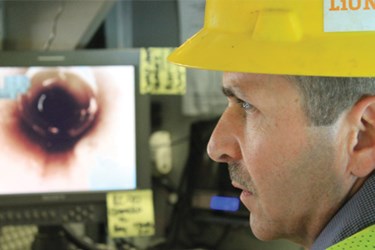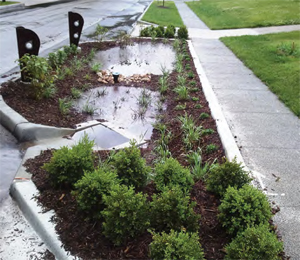K.C. Masterpiece: Revolutionary Combined Sewer Overflow Control


Kansas City, MO, is breaking new ground in more ways than one, instituting the largest and most innovative infrastructure project in the city’s history.
Aging sewer infrastructure has become an issue of national concern. The U.S. EPA estimates that each year more than 850 billion gallons of combined sewer overflow is discharged into local streams and rivers. To address this public health concern, the EPA has estimated a total investment of $57 billion dollars to reduce combined sewer overflows (CSOs) across 772 communities. For the communities impacted by these CSOs, the challenge is great. In Kansas City, MO, the solution is the first of its kind.
Big Plans
Kansas City is emerging as a leader in developing strategic and data-driven solutions for the city’s CSOs, which are estimated to total 6.4 billion gallons of overflow each year. In 2010, Kansas City’s Federal Consent Decree became the first in the nation to receive approval from the EPA for the use of green infrastructure solutions to address CSOs. The green infrastructure solutions included in the city’s federally mandated consent decree are part of Kansas City’s Overflow Control Program, a $4.5 to $5 billion plan to reduce CSOs by 88 percent over 25 years. The Overflow Control Program represents the largest infrastructure investment in the history of Kansas City and has consequently received considerable attention from residents and civic leaders who are interested in maximizing the benefit of such a historic undertaking.
“Kansas City is working to leverage each dollar spent as part of the Overflow Control Program to maximize the benefit to our residents,” said Troy Schulte, city manager for the city of Kansas City, MO. “The knowledge we are collecting from this work, combined with strong public and private partnerships, has enabled Kansas City to transform communities while meeting the requirements of our consent decree. The Overflow Control Program is an example of how our city has taken a challenge and used it to create smart solutions and stronger communities.”
Tech To The Rescue
This year, Kansas City is scheduled to release an innovative technology initiative that will enable the city to capitalize on the investment made as part of the Overflow Control Program. The initiative is a cutting-edge Web application (app) that allows city staff and Overflow Control Program stakeholders to quickly access and utilize terabytes of the city’s sanitary sewer data, largely collected as part of the city’s Overflow Control Program. The application is the first to combine multiple, off-the- shelf technologies for the assessment and use of sanitary sewer data. Kansas City created the application using the Web Application Builder produced by Esri. The city’s sanitary sewer data, which includes CCTV video footage, field investigation reports, smoke testing reports, and manhole inspections, are analyzed and categorized by a data-management technology called InfoMaster produced by Innovyze.
“The sanitary sewer application is changing the way our project teams serve our customers and the way we address the challenges of our aging sewer system,” said Andy Shively, engineering officer for Kansas City Water Services. “Previously, this kind of data had to be accessed using specialized desktop software or would need to be shared with project teams and subcontractors using massive storage drives.”
Using these analytical engines, Kansas City is able to mine more than 30 terabytes of existing sewer condition data to produce heat maps which identify portions of the sewer system that require the most urgent attention. The survey information in the app is also searchable, providing project teams with detailed information that can be accessed using smartphones or tablets from the field.
Additional sewer surveys, conducted as part of the city’s Overflow Control Program, are expected to generate up to 50 terabytes of data. After releasing the sanitary sewer application, Kansas City has plans to develop a custom portal which will contain access to a series of applications such as private inflow and infiltration information, field management applications, and flow metering viewers.
“Building a legacy for Kansas City requires strategic and datadriven solutions that maximize benefits for our community,” said Shively. “This leading technology initiative is important for the strategic and long-term plan for our utility, and it is paving the way for better service and smarter solutions for future generations.”
Green vs. Gray
The analysis and classification of this massive amount of data is helping project teams associated with Kansas City’s Overflow Control Program develop and improve upon both green and gray infrastructure solutions. Kansas City’s federally mandated consent decree allows for the replacement of gray infrastructure with green solutions when those plans are demonstrated to be similar in both cost and performance. Because the Overflow Control Program represents the largest infrastructure investment in Kansas City’s history, city officials are committed to using this investment to encourage future neighborhood investments.
 In an effort to leverage this investment for the betterment of local neighborhoods, Kansas City has allocated more than $68 million for the installation of green infrastructure projects. This investment is already proving to be successful, both in the reduction of combined sewer overflows and in strengthening the local community.
In an effort to leverage this investment for the betterment of local neighborhoods, Kansas City has allocated more than $68 million for the installation of green infrastructure projects. This investment is already proving to be successful, both in the reduction of combined sewer overflows and in strengthening the local community.
In 2012, the completion of Kansas City’s nationally recognized green infrastructure pilot project showcased the community and environmental benefits of incorporating green infrastructure solutions for the on-site control of rainwater. The purpose of the pilot project was to test a wide range of infrastructure and streetscape improvements to reduce combined sewer overflows within a 100-acre area pilot project area. Before receiving EPA approval to replace gray infrastructure with green solutions, Kansas City had planned for the installation of two large storage tanks. Measured in cost-per-gallon, this gray infrastructure solution had represented one of the more costly improvements in the early years of the program.
In 2013, Kansas City filed a report with the EPA confirming that the green solutions in the completed 100-acre pilot project area are successfully performing on-par with more traditional gray infrastructure solutions — but with the added benefit of revitalizing a community. The completed pilot project area achieved a total constructed storage volume of 360,320 gallons thanks in part to the installation of more than 130 best management practices (BMPs) such as rain gardens, permeable pavers, and porous sidewalks. Construction for the remaining 644 acres of green infrastructure improvements will be conducted this year.
“The green infrastructure solutions included as part of Kansas City’s Overflow Control Program are transforming neighborhoods and serving as a catalyst for city and community partnerships,” said Shively. “Kansas City’s plan to replace gray infrastructure with green solutions was born from data and strategic planning, and it is made possible through strong partnerships with the local community.”
Contagious Commitment
This investment and the proven success of the city’s green infrastructure pilot project have instigated a citywide commitment to sustainability. In 2014, Kansas City’s mayor pro tempore became one of the first elected officials in the nation to achieve accreditation as an Envision Sustainability Professional, and the program has served as a guide for sustainable practices throughout all city departments. Kansas City Water Services is leading the city’s sustainable initiative by incorporating the Envision principles into project planning for the Overflow Control Program and into the long-term plan for the utility. Additionally, collaboration among various city departments has enabled the strategic allocation of city resources that will further enhance the community investment in green infrastructure solutions. Stakeholders representing the city’s Parks and Recreation, Public Works, Neighborhoods and Housing Services, and Planning and Development departments convene on a monthly basis to discuss ways that resources and services in the green infrastructure project area can be improved. This collaboration has already resulted in streetscape improvements, enhanced trash services, and the reallocation of vacant properties.
In addition to pooling municipal resources to enhance the city’s existing green infrastructure investment, this group has worked to assist community leaders to request public funding for enhancements to neighborhood curbs and sidewalks which will provide safe connections for pedestrians and bicyclists in the community.
About The Author
 Jennifer Rusch is a strategic marketing professional specializing in communicating complex infrastructure programs in relatable and understandable ways to the public. She lives and works in Kansas City, MO.
Jennifer Rusch is a strategic marketing professional specializing in communicating complex infrastructure programs in relatable and understandable ways to the public. She lives and works in Kansas City, MO.
